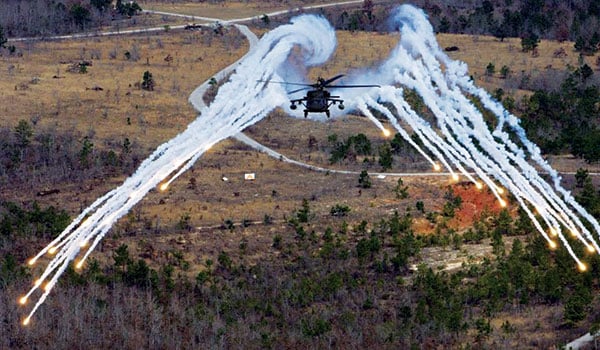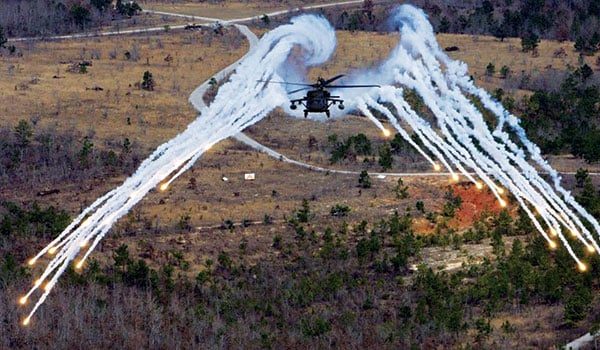
Program Executive Officer, Aviation / By BG Robert L. Marion: The challenges for Army Aviation are extremely complex and approaching us quickly. They also present extraordinary opportunities for our Army and our industry partners.

Aviation survivability continues to evolve to keep pace with current and emerging threats. / U.S. ARMY PEO AVIATION PHOTO
Because we live in a time where everything moves at a lightning pace, our ability to innovate and react quickly is important now more than ever. If we take a serial approach to meet our critical needs, maturing technology within the Science and Technology (S&T) community, progressing capabilities through the Acquisition and Materiel Development process, and finally delivering materiel into the hands of our soldiers, we will not keep pace with evolving threats. The senior leadership within the Army and the Office of the Secretary of Defense (OSD) are well aware of the challenges we face and have already taken steps to increase our pace in the development and fielding of key technologies. Our senior officers and civilians who manage the Requirements, S&T, and Acquisition processes have prioritized innovation and acceleration, and see closer collaboration between the three communities as a means to expedite development and fielding of our critical technologies. The extent of this cooperation within the Army, and across our sister services, is growing every day.
The Aviation Materiel Enterprise, with the support of our industry partners, continues to provide our combatant commanders with unmatched rotary wing lift and lethality. Given that our Army Aviation platforms continue to perform exceptionally well, and facing the difficulty of developing and delivering new capability in a fiscally constrained environment, it would be easy to grow complacent and rest on our laurels. But to maintain overmatch on the battlefield, we must evolve critical capabilities including precise navigation and effective self-protection for our aircraft and crews. It should come as no surprise that these areas are top priorities. Our program managers are working closely and diligently with the extended Army and OSD community to address the current and potential threats we face.
PNT Initiatives
The Army Aviation community is working to implement multiple technologies associated with the Army’s Assured Position, Navigation, and Timing (PNT) initiatives. PEO Aviation is teaming with the Army Product Director for PNT, the Air Force, and the Navy to implement solutions that maintain effective PNT in various levels of GPS degradation. The first initiative is the integration of new Military (M-Code) receivers into our next generation Embedded GPS Inertial Navigation (EGI) Systems and Doppler GPS Navigation Systems (DGNS). We are doing this by taking full advantage of ongoing Air Force M-Code development and production efforts. We are also leveraging new anti-jamming antennas based on work accomplished by the Navy. Eventually, almost all of our aircraft will be equipped with these systems. In parallel, we continue to improve our non-GPS based subsystems to enable operations in completely GPS denied environments. Work is also ongoing to develop small form factor M-Code receivers for use in our small and tactical unmanned aircraft systems platforms where space limitations preclude the use of a standard EGI. Ground based systems, such as mobile air traffic control centers, will rely on M-Code devices provided by PD PNT.
Advanced Survivability Solutions
As the Army Aviation community strives to maintain our battlefield superiority, threat capabilities are maturing more aggressively than ever before. In order to meet this evolving challenge, PEO Aviation and PEO Intelligence Electronic Warfare and Sensors (IEW&S) are teaming with multiple agencies to identify, develop, and mature innovative technical solutions to provide world class protection to our Soldiers. Advanced survivability development areas include system improvements to existing missile warning and radar warning receivers, improved laser detection, and improved countermeasure capabilities. These advanced solutions are being jointly developed with our industry partners and subject matter experts from all services.
Finding a Balance
While we develop these new critical technologies, we also realize that we must continue to increase reliability and reduce the maintenance burden on the field. From a logistics perspective our acquisition process must include initiatives that reduce sustainment costs, extend service life, reduce logistics footprint, and support operations in denied environments, while maintaining mission readiness and capability. Similar to the alignment of Requirements, S&T, and Acquisition processes described above, PEO Aviation is working closely with organizations including the Aviation and Missile Command (AMCOM) and the Aviation and Missile Research, Development, and Engineering Center (AMRDEC) to identify policies and procedures that are an impediment to logistics innovation, or that prevent our users from taking full advantage of the improved reliability and usable life of advanced aircraft components and systems. As we move forward to develop, demonstrate, and transition innovative technologies to improve our systems, we must seize the opportunity to improve maintenance procedures, sustainment concepts, and obsolescence management to reduce the burden on the field. The challenge is finding a balance that improves new and existing systems, corresponding fleet management tools, and supply chain/sustainment infrastructure to increase reliability, reduce downtime, and improve operations and sustainment (O&S) costs.
Although the challenges of continual innovation are significant, I am confident that our extended aviation community is equipped and prepared to meet them head on.
BG Robert L. Marion is the Army Program Executive Officer for Aviation located at Redstone Arsenal, AL.










